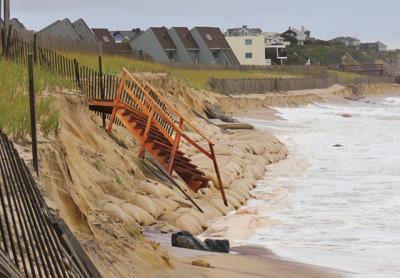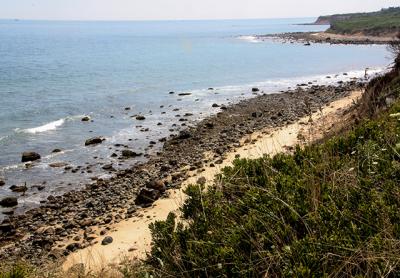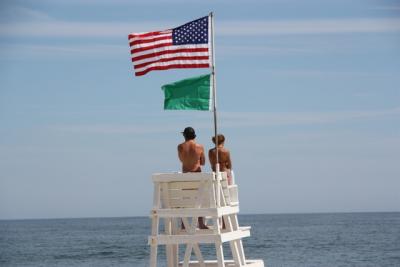Corps May Approve More Montauk Sand
Corps May Approve More Montauk Sand

The Army Corps of Engineers’ plans for the downtown Montauk beach could include adding enough sand to create a 50-foot-wide beach along an expanse roughly double the length of the area where the corps has installed a sandbag wall, representatives said last week.
The design would be in line with what East Hampton Town officials have requested and would be a more extensive project than what is proposed in the corps’s long-awaited Fire Island to Montauk Point shoreline restoration plan, which includes coastal projects of various types along 83 miles of Long Island’s south shore. The plan was the subject of a hearing at the Montauk Playhouse on Sept. 30.
A draft plan had proposed the addition of only 120,000 cubic yards of sand in front of the sandbag seawall on the downtown beach, to be replenished by the federal agency once every four years for a 30-year period. But what is needed, according to a report prepared for East Hampton Town, is an immediate influx of 759,000 cubic yards of sand along 6,000 feet of shoreline, with 414,000 more cubic yards added every four years.
Steve Couch of the Army Corps said at the Sept. 30 meeting that the Corps had just that day received the town’s request and accompanying data, but that “our thinking is really in line with what the town is proposing.”
The Army Corps had already determined that adding enough sand to create a 40 to 50-foot-wide beach was “appropriate methodology” to provide the needed level of protection from ocean surges during storms, he said, in order to protect the buildings on the waterfront and in low-lying downtown Montauk.
The agency is also considering extending the area of beach where sand would be added by 1,500 feet to the east and west of the 3,100-foot stretch where the sandbags have been installed.
“This is the type of feedback we’re looking for,” he said. The ultimate plan, said an Army Corps spokeswoman, must be determined to be “engineeringly feasible, economically justified, and environmentally acceptable.”
The audience at the Montauk Playhouse presentation last week applauded East Hampton Town Supervisor Larry Cantwell as he delivered the town’s request for a “full-scale beach replenishment project.”
New York State Assemblyman Fred W. Thiele Jr. also endorsed that recommendation, saying that the proposed sand addition was “simply not adequate when it comes to the protection of downtown Montauk,” an area he called “environmentally sensitive” and an “economically important area for all of Long Island.”
The ocean beach is Montauk’s “single most important attraction,” said Paul Monte of the Montauk Chamber of Commerce. The sand addition outlined in the draft Fire Island to Montauk plan is “a mere drop in the bucket,” he said, “and falls far short of what is needed.”
Aram Terchunian of First Coastal, a coastal geologist hired by East Hampton Town to draft its response to the corps, said that his economic analysis concluded that a more substantial beach reconstruction could avoid $8 million in potential damages from floods, and ensure “approximately $4 million in recreation benefits” reaped by visits to the Montauk beach by some 300,000 visitors a year who stay in Montauk motels. Anecdotal evidence from the Montauk Chamber of Commerce, Mr. Terchunian said, showed that bookings decline when the beach area narrows.
Montauk, he said, needs a “sustainable beach” to maintain its economic activity.
Beach sand in front of the sandbag wall was eroded last month when Tropical Storm Hermine churned up seas over several days. Sand on top of the bags was also washed away and a number of the exposed sandbags were damaged. Surf conditions earlier this week left more bags uncovered, and water lapping at the sandbag wall, eliminating any dry area of the beach.
The sandbag wall “performed as expected, as designed,” Mr. Terchunian said, by keeping the ocean away from shorefront buildings, “but clearly it’s not enough.”
“We feel that it did do what it was supposed to do,” said the Army Corps spokeswoman.
The installation of the sandbags was completed in advance of the Army Corps’s Fire Island to Montauk Point project as an emergency measure, with funding provided by Congress after Hurricane Sandy. It was described as an interim measure until the projects covered in the shoreline study could be undertaken.
The corps is not planning to remove the sandbags, as had been expected, it was learned last week. Instead, they would become “a backstop” to the restored beach, and provide “a higher level of risk reduction in the area,” said Mr. Couch.
With an expected 15-year lifespan, they would simply be removed piecemeal as bags reached the end of their useful life.
“We need to talk seriously about how we can get those sandbags out of there,” Jeremy Samuelson, the president of Concerned Citizens of Montauk, said to a round of applause from attendees at the hearing. “Managed retreat,” he said, is the only long-term solution to shoreline issues. He endorsed the idea of a “large-scale, sand-only” bolstering of the beach “as we transition to managed retreat over time.”
In some cases, the Army Corps’s plan proposes the purchase of real estate to eliminate coastal development, following a policy of “retreat” from rising sea levels and encroaching surf.
The estimated $1.1 billion cost of all the projects contained in the plan includes $603 million for property purchase for changes to buildings within the floodplain, a strategy endorsed by some as the only logical, long-term response in the face of expected sea level rise.
Using some of the project funding to purchase real estate along the oceanfront, eliminating development in the flood zone, as is proposed for some of the other areas of Long Island, “would be a powerful long-term plan that would last a lot longer than 30 years,” said Carl Irace, an East Hampton attorney who represents Defend H2O, an environmental group that has challenged the Army Corps seawall project in court.
Though many at last week’s meeting were glad to hear that the Army Corps will consider adding additional sand to the Montauk beach, even that reconstruction would be “a stopgap measure,” said Kevin McAllister of Defend H2O.
“We need to move back that front row of buildings,” he said, and rebuild dunes “with beach vegetation that that will take, and hopefully we will have a viable beach dune system,” he said to sustained applause from the audience.
The proposal for downtown Montauk was minimal in comparison to other projects proposed for the long-range shore protection project area, but despite requests that beach restoration be considered for Ditch Plain, it includes for areas east of Montauk’s downtown.
“I think disregarding Ditch Plains is a big mistake,” Lou Cortese of the Ditch Plains Association said at last week’s hearing, citing $200 million in property values in the area, and the potential environmental damage to the ocean beach as well as Lake Montauk should it be inundated and septic systems wiped out. Investment in the area did not meet the corps’s economic cost-to-benefit test, said Mr. Couch, but additional information submitted by the town in that regard will be assessed, he said.
The Army Corps is proceeding separately on a project to shore up the stone armoring around the base of the Montauk Lighthouse, extending and repairing the revetment. That project is not a part of the Fire Island to Montauk Point plan.








